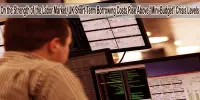Despite recent instability in the banking industry, inflation increased in February but remained in line with predictions, presumably keeping the Federal Reserve on track for another interest rate hike next week.
According to data released by the Labor Department on Tuesday (March 14, 2023), the consumer price index grew by 0.4% for the month, bringing the annual inflation rate to 6%. Both readings were exactly in line with Dow Jones estimates.
Excluding volatile food and energy prices, core CPI rose 0.5% in February and 5.5% on a 12-month basis. The yearly level was in line, while the monthly number was somewhat over the 0.4% prediction.
Following the news, stocks rose, and early trading saw the Dow Jones Industrial Average rise by more than 300 points. Treasury yields, which plummeted Monday amid fears over the banking industry’s health, rebounded solidly, pushing the policy-sensitive 2-year note up 30 basis points to 4.33%.
Markets had anticipated that the Fed would approve an additional 0.25 percentage point hike to its federal funds rate benchmark going into the announcement. That probability rose following the CPI report, with traders now pricing in about an 85% chance that the Fed will hike the rate by a quarter point, according to a CME Group estimate.
“Even amid current banking scares, the Fed will still prioritize price stability over growth and likely hike rates by 0.25% at the upcoming meeting,” said Jeffrey Roach, chief U.S. economist at LPL Financial.
A decrease in energy costs helped keep the headline CPI reading in check. The sector fell 0.6% for the month, bringing the year-over-year increase down to 5.2%. A 7.9% decline in fuel oil prices was the biggest mover for energy.
Food prices rose 0.4% and 9.5%, respectively. Meat, poultry, fish and egg prices fell 0.1% for the month, the first time that index has retreated since December 2021. Eggs in particular tumbled 6.7%, though they were still up 55.4% from a year ago.
Shelter costs, which make up about one-third of the index’s weighting, jumped 0.8%, bringing the annual gain up to 8.1%. Fed officials largely expect housing and related costs such as rent to slow over the course of the year.
“Housing costs are a key driver of the inflation figures, but they are also a lagging indicator,” said Lisa Sturtevant, chief economist at Bright MLS. “It typically takes six months for new rent data to be reflected in the CPI. The quirk in how housing cost data are collected contributes to overstating current inflation.”
Still, shelter costs accounted for more than 60% of the total CPI increase and rose at the fastest annual pace since June 1982.
Because of the housing expectations, Fed officials have turned to “super-core” inflation as part of their toolkit. That entails core services inflation minus housing, a cohort that increased 0.2% in February and 3.7% from a year ago, according to CNBC calculations. The Fed targets inflation at 2%.
Used vehicle prices, a key component when inflation first began surging in 2021, fell 2.8% in February and are now down 13.6% on a 12-month basis. New vehicles have risen 5.8% over the past year, while auto insurance has climbed 14.5%. Apparel rose 0.8%, while medical care services costs decreased 0.7% for the month.
The CPI is one of the important metrics the Fed uses to determine monetary policy because it monitors a wide range of goods and services. The report along with Wednesday’s producer price index will be the last inflation-related data points policymakers will see before they meet March 21-22.
The recent instability in the banking industry has sparked rumors that the central bank may soon announce a halt to rate hikes as policymakers assess the results of a number of tightening measures taken over the previous year.
Markets on Tuesday morning were pricing a peak, or terminal, rate of about 4.95%, which implies the upcoming increase could be the last. Futures pricing is volatile, though, and unexpectedly strong inflation reports this week likely would cause a repricing.
Either way, market sentiment has shifted.
Fed Chairman Jerome Powell last week told two congressional committees that the central bank is prepared to push rates higher than expected if inflation does not come down. That set off a wave of speculation that the Fed could be teeing up a 0.5 percentage point hike next week.
However, the collapse of Silicon Valley Bank and Signature Bank over the past several days paved the way for a more restrained view for monetary policy.
“While only moderately higher than consensus, in the pre-SVB crisis world this may well have pushed the Fed to hike 50bp at its March meeting next week. It is a sign of how much things have changed in the very near term that 50bp is almost certainly still off the table for March,” wrote Krishna Guha, head of global policy and central bank strategy for Evercore ISI.
Guha said it’s still possible the Fed keeps raising rates to a terminal rate in the “high 5s” if its efforts to restore stability in banking are successful.
















